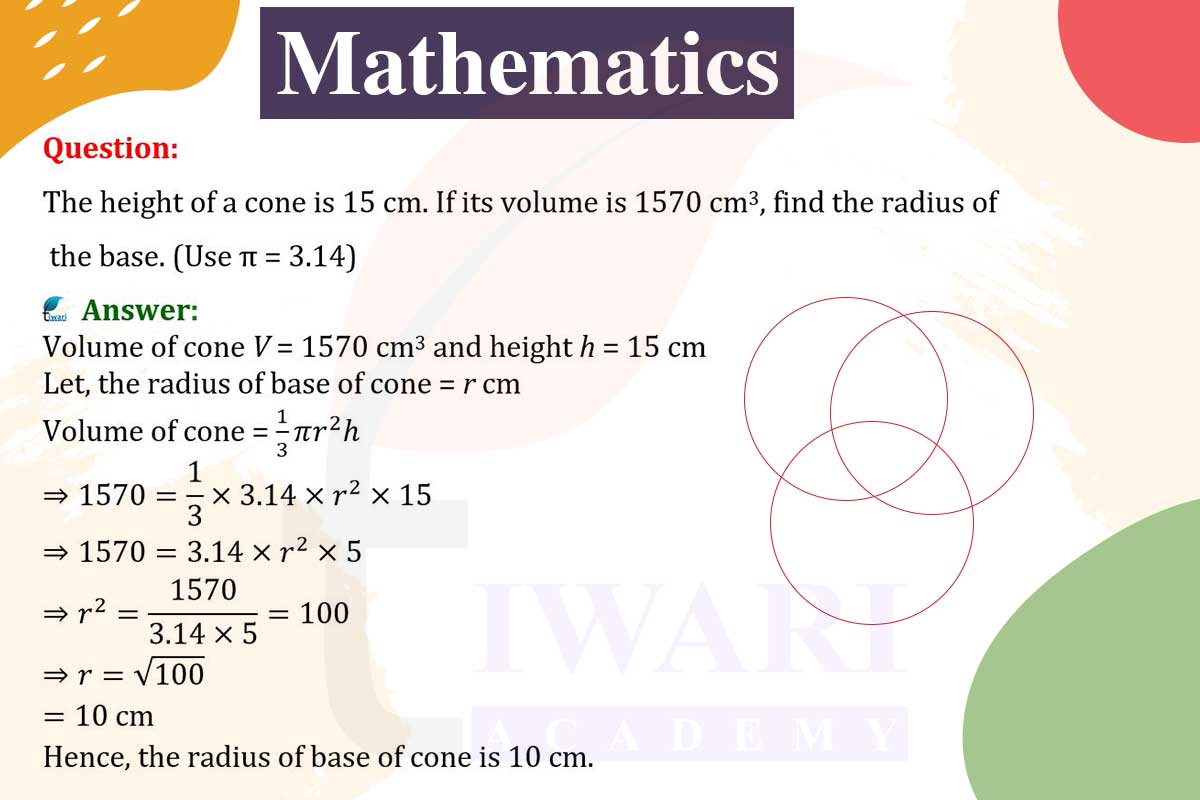To find the radius of a cone given its height and volume, we use the formula for the volume of a cone, V = (1/3)πr²h, where V is the volume, r is the radius, and h is the height. Rearranging the formula to solve for r, we get r = √(3v/πh).
Substituting the given values, V = 1570 cm³ and h = 15 cm, and using π = 3.14, we find r = √[(3 × 1570)/(3.14 × 15)].
Calculating this gives the radius of the base of the cone.

Let’s discuss in detail
Cone Volume and Radius Calculation
The task of determining the radius of a cone from its volume and height is a classic problem in geometry, illustrating the practical application of mathematical formulas. A cone is a three-dimensional shape with a circular base that tapers smoothly to a point, known as the apex. The volume of a cone is a measure of the space it occupies, and it’s directly related to the cone’s height and the radius of its base. This relationship is governed by a specific mathematical formula, making it possible to calculate one dimension if the others are known.
Understanding the Volume Formula of a Cone
The volume of a cone is calculated using the formula V = (1/3)πr²h, where V is the volume, r is the radius of the base, h is the height of the cone, and π is a mathematical constant approximately equal to 3.14. This formula is derived from the principle that the volume of a cone is a third of the volume of a cylinder with the same base and height. The formula is a cornerstone in geometry, enabling the calculation of the volume for various applications.
Rearranging the Formula to Find the Radius
To find the radius of a cone when the volume and height are known, the volume formula needs to be rearranged. By isolating the radius on one side of the equation, the formula becomes r = √(3v/πh). This rearrangement allows for the calculation of the radius based on the known volume and height. It’s a straightforward process that involves substituting the known values into the formula and solving for r.
Applying the Formula to a Specific Problem
In the given problem, the height (h) of the cone is 15 cm, and the volume (V) is 1570 cm³. By substituting these values into the rearranged formula, along with the value of π as 3.14, the calculation becomes r = √[(3 × 1570)/(3.14 × 15)]. This calculation will yield the radius of the cone’s base, which is the unknown dimension we seek to find.
Calculating the Radius
Performing the calculation, we first multiply the volume (1570 cm³) by 3 and then divide by the product of π (3.14) and the height (15 cm). The result of this division is then square-rooted to find the radius. This process demonstrates the practical application of algebraic manipulation and arithmetic operations in solving geometric problems. The result is the radius of the cone’s base, a crucial dimension for understanding the cone’s overall shape and size.
The Significance of Geometric Calculations
In conclusion, the ability to calculate the radius of a cone from its volume and height is a fundamental skill in geometry, showcasing the real-world application of mathematical principles. This problem-solving approach is not only essential in academic settings but also has practical implications in fields like engineering, architecture, and design. Understanding these concepts allows for the accurate creation and interpretation of three-dimensional shapes, highlighting the importance of geometry in our daily lives and professional endeavors.
Discuss this question in detail or visit to Class 9 Maths Chapter 11 for all questions.
Questions of 9th Maths Exercise 11.3 in Detail

